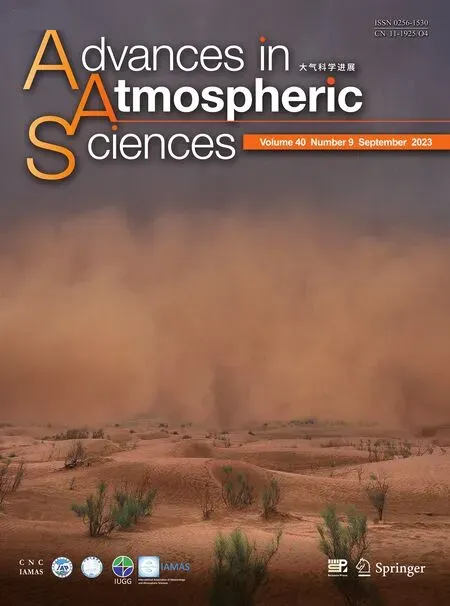Enhanced Seasonal Predictability of Spring Soil Moisture over the Indo-China Peninsula for Eastern China Summer Precipitation under Non-ENSO Conditions
2023-09-07ChujieGAOandGenLI
Chujie GAO and Gen LI
1College of Oceanography & State Key Laboratory of Hydrology-Water Resources and Hydraulic Engineering,Hohai University, Nanjing 210024, China
2Key Laboratory of Meteorological Disaster, Ministry of Education (KLME) & Collaborative Innovation Center on Forecast and Evaluation of Meteorological Disasters (CIC-FEMD), Nanjing University of Information Science and Technology, Nanjing 210044, China
3State Key Laboratory of Tropical Oceanography, South China Sea Institute of Oceanology,Chinese Academy of Sciences, Guangzhou 510301, China
ABSTRACT Seasonal prediction of summer precipitation over eastern China is closely linked to the East Asian monsoon circulation, which is largely affected by the El Niño-Southern Oscillation (ENSO).In this study, results show that spring soil moisture (SM) over the Indo-China peninsula (ICP) could be a reliable seasonal predictor for eastern China summer precipitation under non-ENSO conditions.When springtime SM anomalies are present over the ICP, they trigger a structured response in summertime precipitation over most of eastern China.The resultant south-to-north, tri-polar configuration of precipitation anomalies has a tendency to yield increased (decreased) precipitation in the Yangtze River basin and decreased (increased) in South and North China with a drier (wetter) spring soil condition in the ICP.The analyses show that ENSO exerts a powerful control on the East Asian circulation system in the ENSO-decaying summer.In the case of ENSO forcing, the seasonal predictability of the ICP spring SM for eastern China summer precipitation is suppressed.However, in the absence of the influence of ENSO sea surface temperature anomalies from the preceding winter, the SM anomalies over the ICP induce abnormal local heating and a consequent geopotential height response owing to its sustained control on local temperature, which could, in turn, lead to abnormal eastern China summer precipitation by affecting the East Asian summer monsoon circulation.The present findings provide a better understanding of the complexity of summer climate predictability over eastern China, which is of potential significance for improving the livelihood of the people.
Key words: summer precipitation, El Niño-Southern Oscillation, soil moisture, Indo-China Peninsula, eastern China, East Asian summer monsoon
1.Introduction
China is in a typical monsoonal region with complex terrain and climate features.The monsoon’s influence is especially profound for eastern China, which contains most of China's population with developed agriculture and industry.Under the influence of the East Asian summer monsoon system, summer precipitation over eastern China exhibits a relatively large variability with frequent heavy precipitation activities, often causing severe socioeconomic impacts (Jiang et al., 2008; Wei et al., 2012).For example, the Yangtze River basin (YRB) suffered a huge flood associated with persistent Meiyu precipitation during the summer of 2020 (Takaya et al., 2020; Ding et al., 2021), which affected more than 60 million people and caused economic losses of about 180 billion RMB (Li et al., 2021a).On the other hand, in the summer of 2022, an unprecedented and long-lasting drought affected the YRB, which also caused severe social and economic impacts (Wang et al., 2023).Therefore, the seasonal prediction of summer precipitation anomalies over eastern China is of scientific and social significance.
The atmospheric circulation anomalies over East Asia are largely affected by the tropical sea surface temperature(SST) anomalies (Ju and Slingo, 1995; Ramarao et al.,2016; Chen et al., 2019, 2022a).In particular, El Niño-Southern Oscillation (ENSO) is one of the most predominant climatic phenomena over the tropical oceans, which greatly impacts the atmospheric circulation worldwide (e.g., Philander, 1983; Rasmusson and Wallace, 1983; Huang and Wu,1989; Ge et al., 2017; Ng et al., 2019; Ren et al., 2020; Wu et al., 2021).For instance, an anomalous anticyclonic circulation in the lower troposphere is formed over the western North Pacific during an El Niño, which develops in autumn and matures in winter (Chen and Li, 2022; Chen et al.,2022b).Due to the slow response of the SST anomalies, the anomalous low-level anticyclonic circulation over the western North Pacific can persist until their decay in summer and result in abnormally strong water vapor transport into southern China, thus regulating the regional precipitation(Wang et al., 2003; Xie et al., 2009, 2016; Chowdary et al,2017; Jiang et al., 2019; Li et al., 2021b).Therefore, the SST anomalies of the mature-ENSO winter is regarded as one of the most important predictive signals for precipitation anomalies in the ENSO-decaying spring and following summer over East Asia (e.g., Ju and Slingo, 1995; Zhang et al.,2016; Wen et al., 2019; Li et al., 2021c, 2023; Sun et al.,2021; Xu et al., 2021; Lin et al., 2023).
Land processes are also important for the East Asian climate.For example, anomalous thermal forcing over the Tibetan Plateau is significantly related to summer precipitation over eastern China (Wang et al., 2014, 2018).Located in the upstream region of the East Asian summer monsoon,the Indo-China Peninsula (ICP) plays an important role in mediating the monsoon system.Jin et al.(2006) designed a couple of model sensitivity experiments, with and without the land of the ICP, and concluded that this landscape is indispensable for establishing the East Asian summer monsoon.Zhang and Qian (2002) also found that sensible heating over the ICP strongly affects the onset of the South China Sea monsoon, a part of the East Asian summer monsoon system.In addition, previous studies also suggested that the thermal condition over the ICP in spring is crucial for summer monsoon development and eventually affects the East Asian summer climate (Liu et al., 2010; Wang et al., 2017).
On the land surface, soil moisture is key in adjusting local thermal states (Webster, 1983; Seneviratne et al.,2010; Bellucci et al., 2015).Therefore, over monsoonal areas, soil moisture affects the large-scale atmospheric circulation through its thermal control of the ground surface and can induce remote changes in monsoonal precipitation (Douville et al., 2001; Zuo and Zhang, 2007; Meng et al., 2014;Liu et al., 2017).Due to its strong persistence, a regionalscale soil moisture anomaly provides reliable information for the interests of seasonal climate prediction (Zhan and Lin, 2011; Zuo and Zhang, 2016).In our previous study(Gao et al., 2019), the spring soil moisture anomaly over the ICP has proven to be an important seasonal predictor for the following summer precipitation over the YRB, indicating the potential for a tightly coupled relationship between the ICP spring soil moisture and eastern China summer precipitation.Nevertheless, the synergistic effect of ENSO on such a relationship remains unclear.
In the 1990s, Rowell et al.(1995) investigated the summer precipitation anomaly over North Africa and indicated that soil moisture played a key influential role during certain periods, while the SST usually played the decisive one.Several studies have attempted to assess the differential forcings attributed to soil moisture and SST on climate variations and their relative contributions to regional precipitation(Yang and Lau, 1998; Thiaw and Mo, 2005; Mo, 2008;Yoon and Leung, 2015; Orth and Seneviratne, 2017; Zhou et al., 2020).Their results suggested that summer precipitation is affected by land surface processes mainly during periods when SST anomalies over the Pacific are relatively weak, specifically concluding that the predictive skill of using soil moisture anomalies for summer precipitation in its early stages is unstable against different SST backgrounds(Mo, 2008).New questions arise.Does the effect of the ICP spring soil moisture on eastern China summer precipitation change with the ENSO SST anomaly background, and what is the nature of this change?
Indeed, the present study finds that summer precipitation over eastern China is closely associated with the ICP spring soil moisture anomaly only in the years with relatively weak ENSO SST anomalies.During the spring and summer of ENSO decay, changes in the atmospheric circulation over the western North Pacific are mainly attributed to the ENSO SST anomalies initially formed in its mature winter.Under such a circumstance, the ICP spring soil moisture anomaly exhibits little influence on the atmospheric circulation.In contrast, under non-ENSO conditions, the abnormal ground heating in summer over the ICP induced by local soil moisture anomalies significantly contributes to the monsoon circulation system variability and can remotely affect the abnormal precipitation distribution over eastern China.Thus, the seasonal predictive skill of summer precipitation over eastern China using the ICP spring soil moisture is distinctly enhanced under non-ENSO conditions.
The remainder of this paper is organized as follows.Section 2 introduces the data and methods used in this study.Section 3 explores the relationships between the ICP spring soil moisture and eastern China summer precipitation anomalies and their changes under different SST cases.Section 4 investigates the local thermal variations induced by the ICP spring soil moisture anomaly.Section 5 examines the atmospheric circulation and ICP dry-wet states in spring associated with ENSO.The mechanisms related to the ICP spring soil moisture influencing summer precipitation in eastern China for different SST cases are analyzed in section 6.Section 7 provides a summary and discussion.
2.Data and methods
Ground-based observational monthly precipitation and temperature data are obtained from the University of East Anglia Climate Research Unit (CRU) datasets.These data have a fine horizontal resolution of 0.5° × 0.5° worldwide and can be freely downloaded at the website of https://crudata.uea.ac.uk/cru/data/hrg/.The long-term observational dataset for soil moisture is more difficult to collect (Liu et al., 2014; Cheng et al., 2015).This study employs a longterm dataset including land information from the Global Land Data Assimilation System (GLDAS) version 2.0 with a horizontal resolution of 1.0° × 1.0°.The data and detailed description can be found at https://hydro1.gesdisc.eosdis.nasa.gov/data/GLDAS/.Considering that the land—atmosphere interactions are more effective near the surface(Dirmeyer, 2011), the soil moisture data from the top layer(0—10 cm) is adopted.The monthly atmospheric fields are sourced from the Japanese 55-year reanalysis (JRA-55)datasets, including the geopotential height, three-dimensional wind velocity, and humidity.The Japan Meteorological Agency provides the JRA-55 datasets with a horizontal resolution of 1.25° × 1.25° at the website https://jra.kishou.go.jp/JRA-55/index_en.html.Due to the different time spans in different datasets, we set the study period as 1958—2014 to cover the shared time span.Seasonally averaged data is calculated by a three-month mean, with winter defined as January and February of the current year in addition to December of the previous year.For example, the winter of 1958 refers to the December of 1957 and January-February of 1958.
The Oceanic Niño Index (ONI) is based on the SST anomalies over the Niño-3.4 region, and it was gathered from the Climate Prediction Center of the U.S.at http://origin.cpc.ncep.noaa.gov/products/analysis_monitoring/ensostuff/ONI_v5.php.The ONI in the ENSO-mature winter is employed to denote the positive/negative phase and intensity of the ENSO events (Li et al., 2021b).In this study, 33 years with an absolute value of the winter ONI less than or equal to 0.8 are selected as the “quasi-normal”tropical Pacific SST years (list not shown), and they are referred to as non-ENSO years/conditions.On the contrary, the ENSOdecaying years (referred to as ENSO years/conditions hereafter) are the remaining 24 years with absolute values of the winter ONI larger than 0.8 (list not shown).To avoid the influence of ENSO, we utilize a regression-based approach to exclude the ENSO signal in the spring soil moisture anomalies over the ICP as follows:
where V and V* are the variations of the soil moisture after and before removing the ENSO signal, respectively, S is the winter ONI (for the ENSO SST anomaly), cov(V*, S) is the covariance between the soil moisture and the ONI, and var(S) is the variance of the ONI.In this way, the ENSO signal is removed in the 33 non-ENSO years and 24 ENSO years for ICP spring soil moisture.
In the JRA-55 dataset, the atmospheric variables are arranged from the bottom layer (1000 hPa) to the top (1 hPa).The water vapor flux in the troposphere was vertically integrated from 1000 to 300 hPa since it rarely exists above 300 hPa.The governing equation is as follows:
where Q is the water vapor flux, g is the acceleration of gravity, q is the specific humidity, andVis the horizontal wind velocity.Note that the main results in this study are essentially the same whether the original data or the data after removing the long-term trend is used.
3.Change in the relationship between the ICP spring soil moisture and eastern China summer precipitation anomalies
Based on our previous study (Gao et al., 2019), the ICP is the region bounded by 11º—25ºN and 96º—108ºE and is an obvious dry-wet transitional zone in spring [Fig.S1 in the electronic supplementary material (ESM)].Meanwhile, the inter-annual variability of the ICP soil moisture is relatively large in spring, and the soil moisture anomaly evidently sustains itself from spring into summer (Fig.S1b).In such circumstances, the ICP spring soil moisture is expected to be an important factor that affects the summer climate.Figure 1 demonstrates the correlation distribution of summer precipitation anomalies over eastern China with the preceding spring soil moisture anomalies averaged over the ICP from 1958 to 2014.The YRB, located in the middle and lower reaches of the Yangtze River, is dominated by negative correlations.In addition, there are strong and weak positive correlations in South China (SC) and North China (NC), respectively.This tri-pole correlation pattern suggests a close linkage between the inter-annual variations in the ICP spring soil moisture and summer precipitation over eastern China.To further examine the relationship between spring soil moisture and summer precipitation anomalies over the ICP and eastern China, the time series of the standardized regional anomalies are shown in Fig.S2 in the ESM for comparison.The ICP spring soil moisture bears correlations of —0.35(p < 0.01), 0.29 (p < 0.05), and 0.13 (insignificant) with the YRB, SC, and NC summer precipitation anomalies, respectively.In other words, when the ICP land surface is abnormally dry in spring, the precipitation of the following summer is usually higher than normal in the following summer over the YRB and lower than normal in SC during the past 57 years, and vice versa.

Fig.1.Correlation distribution of summer precipitation with regionally averaged soil moisture anomalies in the preceding spring over the Indo-China Peninsula (ICP) from 1958—2014.The areas marked with dots are significant (p < 0.05).The red boxes denote the Indo-China Peninsula (ICP; 11º—25ºN,96º—108ºE), South China (SC; 23º—27ºN, 109º—117ºE), the Yangtze River basin (YRB; 28º—33ºN, 105º—118ºE), and North China (NC; 35º—42ºN, 105º—112ºE), respectively.
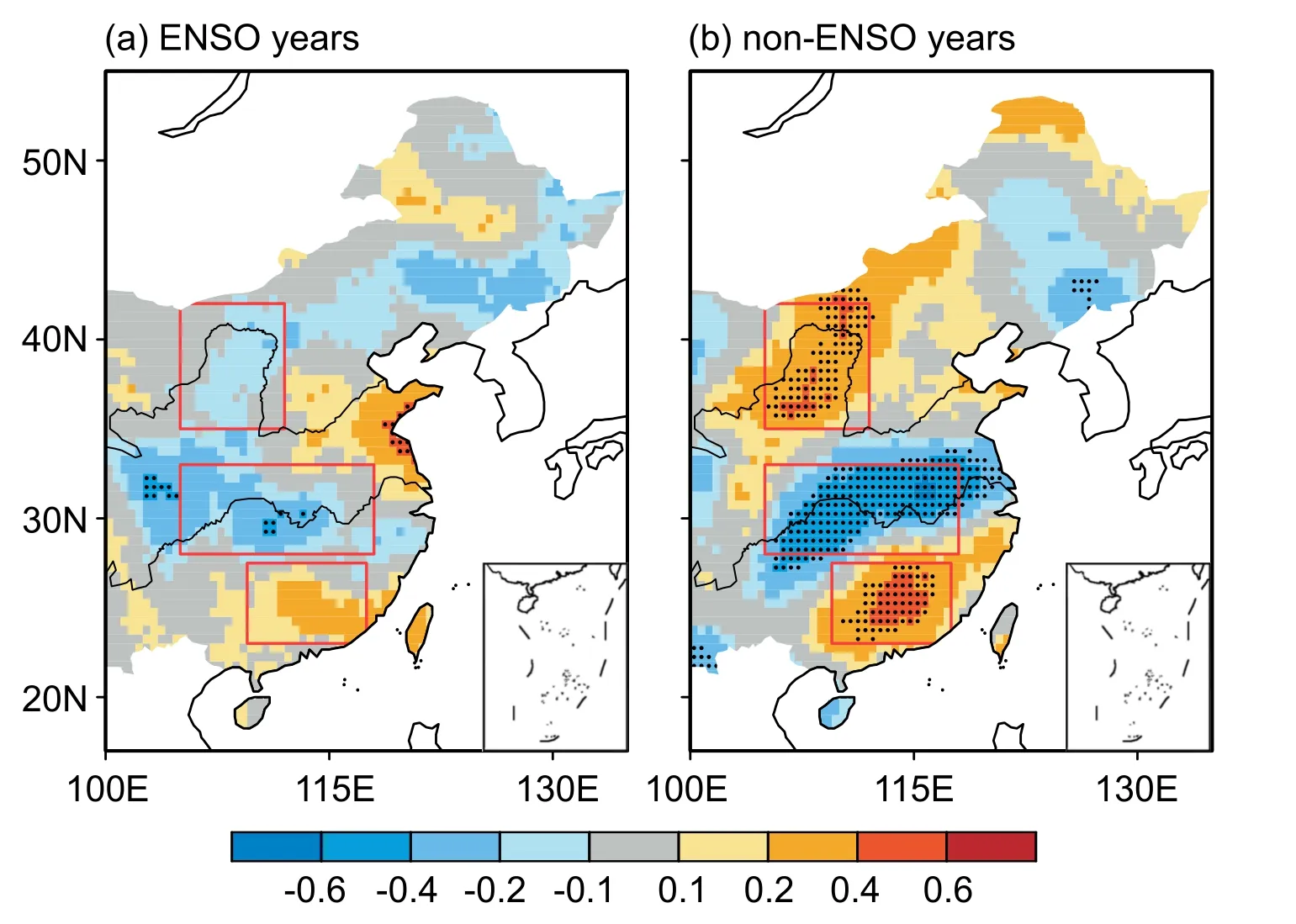
Fig.2.Correlation distributions of summer precipitation with regional averaged soil moisture anomalies in the preceding spring over the ICP during (a) the ENSO years and (b) non-ENSO years.The areas marked with dots are significant with p < 0.05.The red boxes denote the SC,the YRB, and the NC.
However, such soil moisture-precipitation relationships change against the ENSO SST anomaly backgrounds.In ENSO years, the negative correlations are weaker and only exist over central China (northwest to the YRB) and the middle YRB (Fig.2a).The positive correlation is much weaker in SC and even turns to negative in NC, indicating that the effect of spring soil moisture anomaly over the ICP on summer precipitation over eastern China is weakened in the presence of strong ENSO SST anomalies from the preceding winter.While in the summers without ENSO, there is an evident tri-pole pattern of “+, -, +”correlations between summer precipitation over eastern China and the ICP spring soil moisture anomaly (Fig.2b).More importantly, the soil moistureprecipitation relationships are much stronger compared to the results over the whole study period and ENSO years(Figs.1 and 2b), further noting that even NC shows a large coverage of significant (p < 0.05) positive correlations in non-ENSO years.
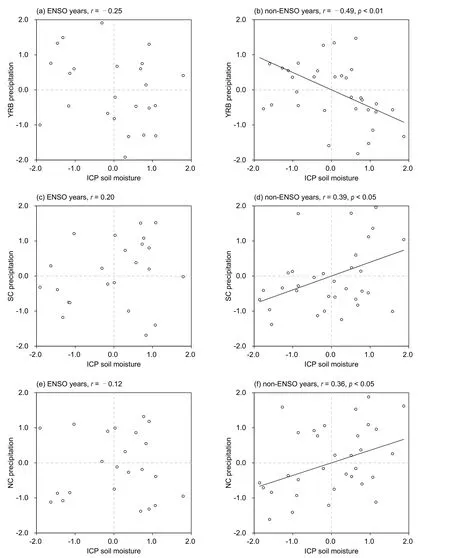
Fig.3.Relationships between normalized anomalies of spring soil moisture over the ICP and summer precipitation over (a, b) the YRB, (c, d) the SC, and (e, f) the NC for (a, c, and e) the ENSO years and (b, d, and f) the non-ENSO years.The r and p denote the correlation coefficient and its significance level.
The scatterplots also confirm our above findings (Fig.3).In the ENSO years, the correlation coefficients of the summer precipitation anomalies over the YRB, SC, and NC with the ICP spring soil moisture are only —0.25, 0.20, and —0.12,respectively, which are all statistically insignificant at p >0.1 (Figs.3a, c, and e).In contrast, for the non-ENSO years,such correlation coefficients increase to —0.49, 0.39, and 0.36, which are statistically significant with p < 0.01 for the YRB and p < 0.05 for SC and NC (Figs.3b, d, and f).Our recent study has shown similar results using model simulations (Zhu et al., 2021) in that the spring soil moisture-summer precipitation relationship over the ICP and YRB is weak under a strong tropical SST anomaly condition, while it is clearly evident under the normal SST background.As the most dominant tropical climate forcing factor, ENSO modulates global climatic conditions.Nevertheless, in our present study, the effect of the ICP spring soil moisture on summer precipitation over eastern China is distinctly enhanced under non-ENSO conditions.
4.Local thermal control of soil moisture anomaly over the ICP
Soil moisture affects precipitation through multiple pathways (Seneviratne et al., 2010; Bellucci et al., 2015).In the monsoonal regions, the abnormal surface heating induced by soil moisture anomalies is the first step to affect the monsoon circulation and consequent precipitation patterns (Douville et al., 2001; Dirmeyer, 2011; Zhang and Zuo, 2011).In our previous study (Gao et al., 2019), spring soil moisture anomalies over the dry-wet transitional ICP were important in controlling the local thermal conditions due to their persistence into summer.First, for the ENSO and non-ENSO springs, the land surface dry-wet states over the ICP region exhibit little change (Fig.S3 in the ESM).Therefore, we reexamine the local thermal control of soil moisture anomaly over the ICP for different tropical SST cases.
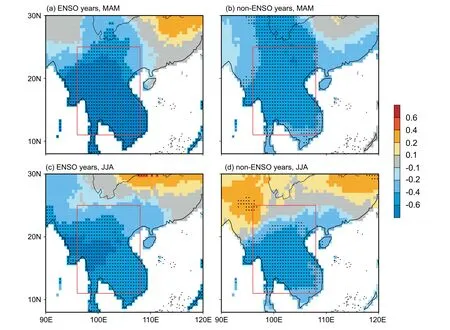
Fig.4.Correlation distributions of observed air temperature with regional averaged soil moisture anomalies in (a)spring and (c) summer during the ENSO years.Panels (b) and (d) are the same as for (a) and (c), but for the non-ENSO years.The areas marked with dots are significant with p < 0.05.The red boxes denote the ICP.
In both the ENSO-decaying and non-ENSO springs,soil moisture anomalies show simultaneously evident negative correlations with the local surface air temperature(Figs.4a, b).This indicates a warmer thermal state corresponding to a former drier land surface over the ICP, owing to weaker evapotranspiration and stronger surface sensible heating (Fig.S4 in the ESM) associated with lower soil moisture (Gao et al., 2019).Moreover, such soil moisture anomalies in spring can persist into summer.Variations of soil moisture in spring over the ICP are significantly correlated with their anomalies in summer for the whole study period, for both ENSO years and non-ENSO years (figure not shown),confirming the strong memory of soil moisture anomalies over the ICP during spring and summer.
The long-lasting soil moisture anomalies continuously impact the local temperature.In summer, the surface air temperature also responds to the soil moisture anomalies with significant negative correlations over the ICP in both ENSO and non-ENSO years (Figs.4c, d).This indicates that the higher temperatures induced by the abnormally dry surfaces over the ICP can sustain themselves until summer in both SST cases.Hence, from the aspect of surface thermal control, soil moisture affects local surface air temperature similarly, regardless of tropical Pacific SST anomaly conditions.
5.ENSO-induced atmospheric circulation anomalies and the ICP dry-wet conditions in spring
To further explore the effects of the ICP soil moisture anomaly on YRB summer precipitation under different tropical SST backgrounds, we first examine the possible relationship between ENSO and ICP dry-wet states.Figure 5a shows the correlation distribution of spring soil moisture anomaly with the preceding winter ONI for 1958—2014.Clearly, the ICP is covered with a large area of negative values.This implies that the ICP land surface is usually drier than normal when the SST is abnormally warmer over the tropical eastern Pacific Ocean (i.e., an El Niño event), and vice versa.This could be in association with the anomalous atmospheric circulation induced by ENSO.
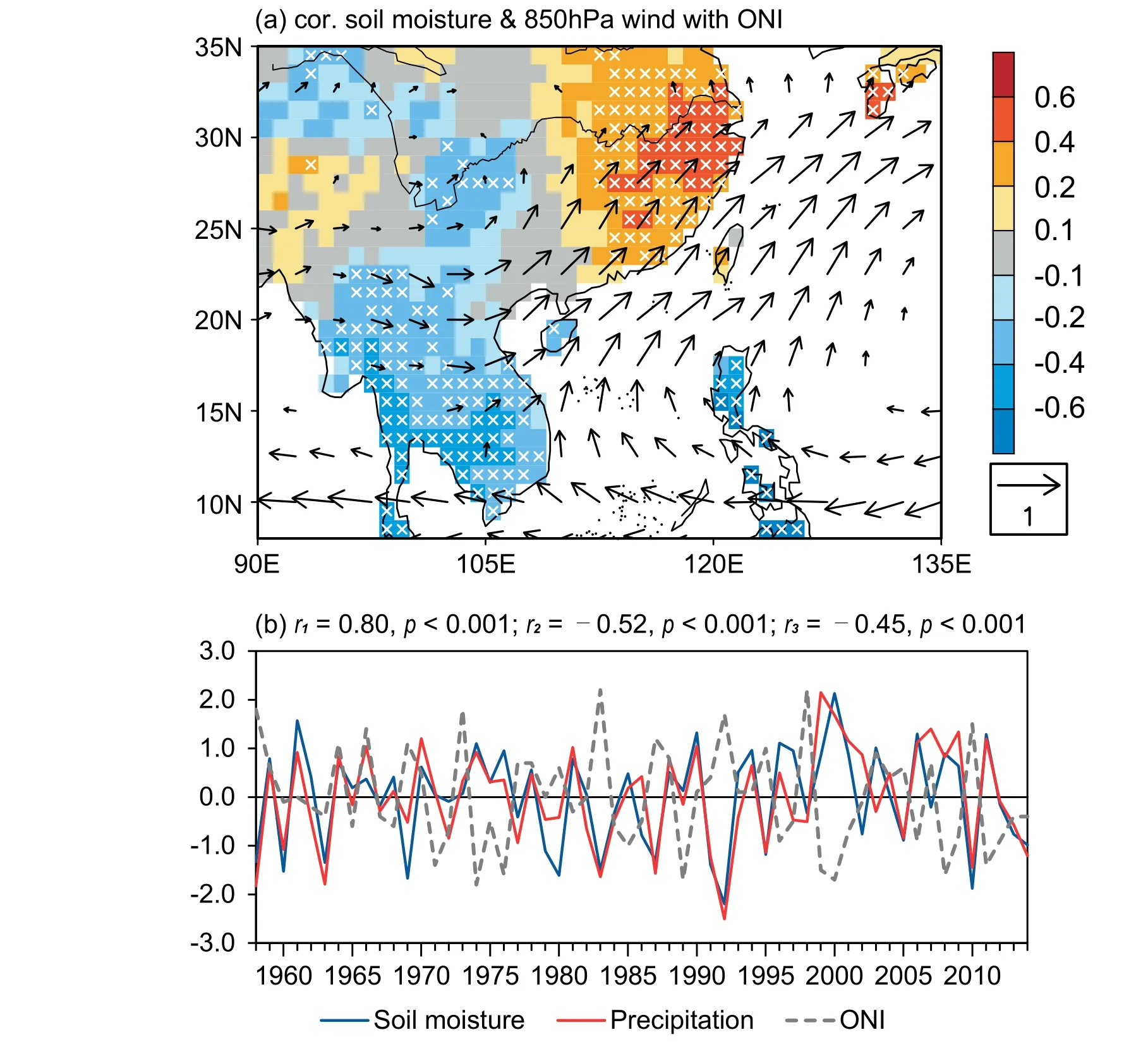
Fig.5.(a) Correlation distribution (colors; areas marked with white cross symbols are significant with p < 0.05) of spring soil moisture anomalies with the preceding winter’s ONI,and the regression (arrows; the shown arrows are significant with p < 0.05) of the 850-hPa wind anomaly (units: m s—1) in spring with respect to the preceding winter’s ONI for 1958—2014.(b) Standardized time series of spring soil moisture and precipitation anomalies over the ICP and the ONI of the preceding winter during 1958—2014.r1, r2, and r3 denote the correlation coefficients between the soil moisture and precipitation anomalies, the soil moisture anomaly and ONI, and the precipitation anomaly and ONI, respectively.The pvalue denotes the significance level.
Figure 5a additionally shows the correlation distribution of the 850-hPa wind field and soil moisture with the ONI.In the decaying spring of an El Niño event, an anomalous anticyclonic circulation in the lower troposphere exists over the western North Pacific according to the anomalous wind pattern.Thus, an abnormal southwesterly wind field is present across the ICP extending into southern China, consistent with our previous studies (Li et al., 2021b, c).Under such a circumstance, excessive water vapor is transported into southern China from the ICP, inhibiting ICP spring precipitation(Jiang et al., 2019).Generally speaking, local precipitation is the main factor determining the land surface dry-wet states (i.e., soil moisture anomaly) over the ICP (Gao et al.,2019).As shown in Fig.5b, the soil moisture and precipitation anomalies in spring over the ICP are closely linked with a correlation coefficient of 0.80 (p < 0.001).This also validates the reliability of the soil moisture data to a certain extent.Meanwhile, they both exhibit a strong relationship with the ENSO SST anomalies.The correlation coefficients of the preceding winter's ONI with the ICP spring soil moisture and precipitation anomalies are —0.52 and —0.45, respectively, both statistically significant with p < 0.001.This confirms that the anomalous atmospheric circulation induced by a positive ENSO SST anomaly usually results in a precipitation deficit over the ICP during the decaying spring, consequently lowering local soil moisture and vice versa.In other words, the inter-annual changes in the ICP spring soil moisture may include the ENSO SST anomaly signals, causing uncertainty in the relationship between the ICP spring soil moisture and the YRB summer precipitation.It is worth mentioning that the YRB and the ICP precipitation anomalies can be considered as a whole in spring (reflected by opposite soil moisture responses to ENSO in Fig.5a), which is commonly influenced by the anticyclone over the northwestern Pacific.While the ICP and YRB precipitation anomalies are correlated in spring, the correlation barely exists in summer (Fig.S5 in the ESM).This would indicate that the YRB summer precipitation anomaly is mainly attributed to an atmospheric circulation anomaly induced by the ICP soil moisture or the tropical SST anomalies.
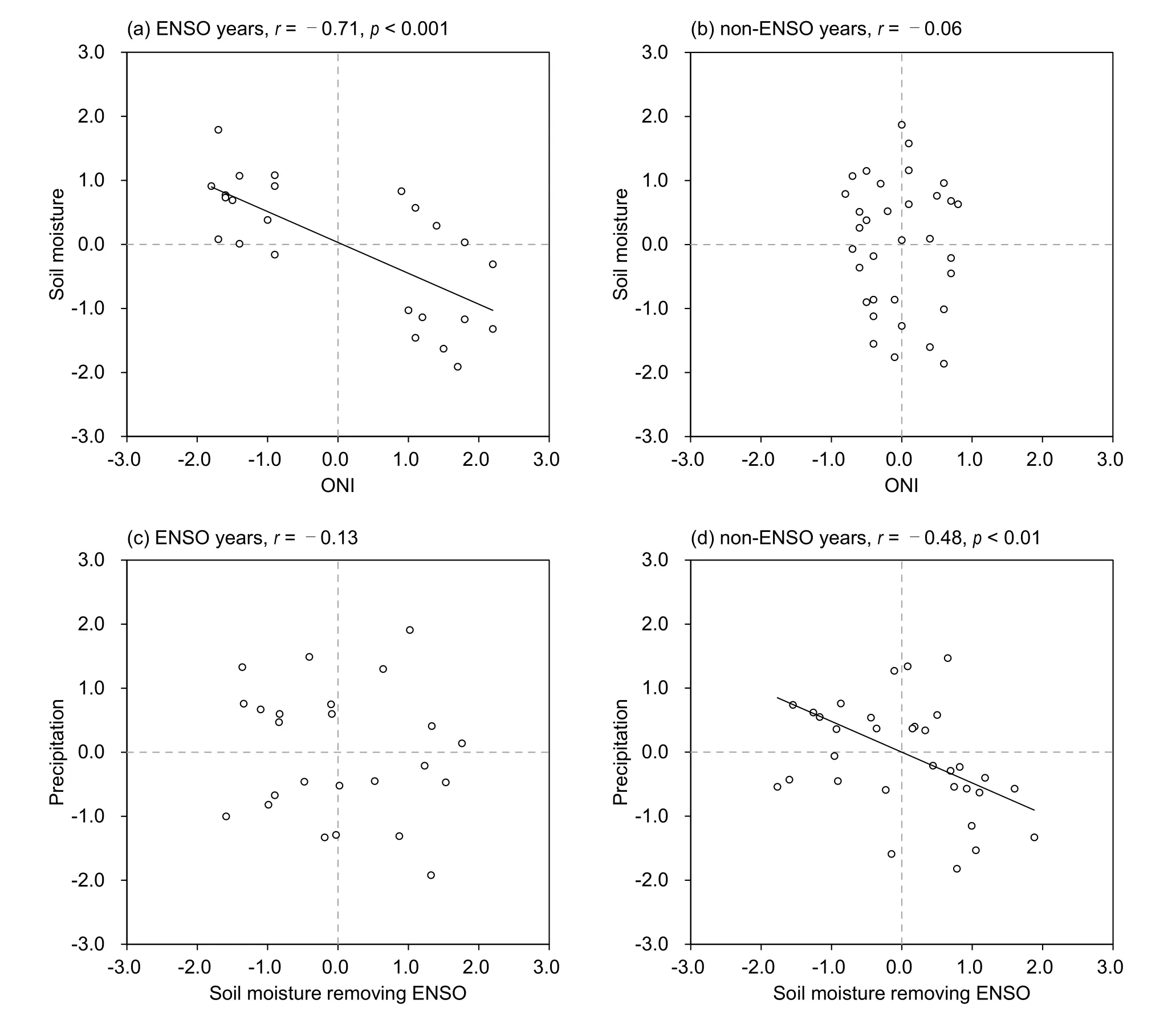
Fig.6.Relationships between (a) the winter ONI and the normalized soil moisture anomaly of the following spring over the ICP, and (c) the spring normalized soil moisture anomaly after removing the ENSO signal and the following summer precipitation anomaly over the YRB for the ENSO years.Panels (b) and (d) are the same as in (a) and (c), but for the non-ENSO years.The r and p denote the correlation coefficient and its significance level in each case.
Figures 6a and 6b further show the scatterplots between the winter ONI and the ICP spring soil moisture anomaly for the different cases.In the ENSO years, the spring soil moisture anomaly over the ICP is closely linked to the ENSO SST anomalies of the preceding winter, as evidenced by correlation coefficients between the winter ONI and the ICP spring soil moisture anomaly as high as —0.71, exceeding the significance level of p < 0.001 (Fig.8a).By contrast, the spring soil moisture anomaly exhibits little connection with the preceding winter's ENSO SST anomalies (Fig.8b) in the non-ENSO years, which indicates that the relatively weaker SST anomalies over the tropical eastern Pacific Ocean in winter exert less of an influence on the ICP precipitation/soil moisture in the following spring.The above results further confirm that the inter-annual ICP soil moisture anomaly in spring contains the SST anomaly signal from the previous winter, especially for the ENSO years.Therefore, it is necessary to re-check the soil moisture-precipitation relationship after removing the ENSO SST anomaly signals.Here, we take the YRB as an example.During the ENSO years, after removing the ENSO SST anomaly signal, the ICP spring soil moisture anomaly exhibits a weak connection with the summer precipitation in the YRB (Fig.6c) with a correlation coefficient of -0.13, while such a connection is profoundly enhanced in the non-ENSO years, evidenced by a robust negative correlation of -0.48 (p < 0.01; Fig.6d).The above findings suggest that the ICP soil moisture anomaly has little impact on summer precipitation over the YRB when the winter ENSO SST anomaly exerts an obvious impact on the following spring’s dry-wet state over the ICP.On the other hand, the ICP spring soil moisture anomaly distinctly affects the YRB summer precipitation when the tropical eastern Pacific winter SST anomaly is relatively weak and exerts little influence on South Asian climates.It is worth noting that the ICP soil moisture—YRB precipitation relationship in ENSO years was even weaker after removing the ENSO signal than before.As shown in Fig.6c, in ENSO years, the correlation coefficient of the ICP spring soil moisture anomaly with the YRB summer precipitation is -0.13, less than the correlation coefficient of -0.25 before the removal of the ENSO signal (Fig.3a).This further indicates that the ENSO signal contained within the soil moisture anomaly affects our statistical analyses, mostly in the ENSO years.
6.Responses of the East Asian summer monsoon system to the ICP soil moisture anomalies
In this section, we explore the relevant mechanisms in the processes of spring soil moisture over the ICP affecting summer precipitation in eastern China.Considering that the ENSO SST anomaly modulates the dry-wet conditions over the ICP in the decaying spring, a set of results are added for comparison using the ICP spring soil moisture anomaly,excluding the ENSO signal.First, we define a soil moisture index (SMI) using the standardized spring soil moisture anomaly averaged over the ICP during our study period.The regression anomalies of the atmospheric circulation related to the negative SMI present favorable and adverse conditions for summer precipitation over the YRB and the SC/NC, respectively.
Theoretically, the abnormal heating on the ground would increase the near-surface air temperature, reducing the pressure in the lower troposphere.On the other hand,the air expands with surface heating, and thus the local geopotential heights at higher levels are uplifted, contributing to the anomalous atmospheric circulation.For the ICP, the abnormal temperature induced by local soil moisture anomalies can further adjust the east-west shift of the Western Pacific subtropical high (WPSH; Gao et al., 2019).Figure 7 illustrates the 500-hPa geopotential height anomalies in response to a negative soil moisture anomaly over the ICP under different cases.For the ENSO-decaying summer, the atmospheric circulation response to a negative SMI is obvious(Fig.7a) as the WPSH is strengthened and dramatically extends westward.However, after removing the ENSO signal, the response of 500-hPa geopotential height to the SMI barely exists (Fig.7c).In non-ENSO summers, as the ICP geopotential height increases, and the main body of the WPSH also extends westward when the ICP land surface is drier by -1 SMI in the preceding spring (Fig.7b).Moreover,such a lagged response of the 500-hPa geopotential height to the SMI after removing the ENSO signal has little effect,as the pattern essentially remains the same (Fig.7d).The significant response area is slightly north and northeast of the ICP, which may be related to the prevailing southwesterly monsoonal wind in the lower troposphere over the heating area.
The WPSH in summer is tightly linked to the SST anomaly of the preceding winter over the tropical eastern Pacific Ocean in such a way that when warmer SSTs are over the tropical eastern Pacific in winter, the summer WPSH is evidently strengthened and extends excessively westward (Fig.S6 in the ESM).Furthermore, this teleconnection is essentially the same after removing the SMI signal.In the decaying summer of a strong El Niño event, the WPSH is usually stronger than normal with a westward extension, which can affect the East Asian summer climate (Luo and Lau, 2019; Huang et al., 2020).Therefore, in ENSO years, the distinctly different responses of the WPSH to the SMI before and after removing the ENSO signal (Figs.7a, b)indicate that the anomalous WPSH in summer is mainly attributed to the ENSO SST anomaly, and the effect of the soil moisture anomaly is minimal.For the non-ENSO years,the summer atmospheric circulation tends to show an evident response to ICP land processes.
The WPSH, on the one hand, guides the low-level airflow.On the other hand, it could potentially impede the northward advance of the summer southwest monsoon.Generally speaking, a stronger WPSH produces anomalously stronger downward motion, and thus the air is abnormally divergent in the lower troposphere, forming a low-level anomalous anticyclone (Fig.S7 in the ESM).As shown in Fig.8, around the western edge of the anomalous WPSH, there is usually an anomalous anticyclonic circulation in the lower troposphere when the ICP soil moisture is abnormally low.For the ENSO-decaying summer, the low-level anomalous wind field extends from the western ICP to central China (Fig.8a)associated with the negative SMI.Similar to the abnormal WPSH, the response of the low-level wind anomaly to the SMI is evidently weaker after removing the ENSO signal(Fig.8c).For the non-ENSO summer, the low-level anomalous anticyclone is shifted eastward with a relatively narrow meridional coverage compared to that of Fig.8a, mainly covering southeastern China (Figs.8b, d).In realizing that the anticyclone over the northwestern Pacific is a major component of the Pacific-Japan teleconnection pattern (PJ pattern;Nitta, 1987; Wu et al., 2016), the anomalous anticyclone also induces an anomalous cyclone on its north side, indirectly associated with the ICP soil moisture anomaly (Fig.S8 in the ESM).In particular, to the south and north of the YRB,an abnormal southwesterly and northerly wind field is evident, respectively.The above findings further indicate that the summer atmospheric circulation changes are mainly associated with the tropical oceanic signal present when there is a strong SST anomaly over the tropical eastern Pacific.Otherwise, for the non-ENSO years, the summer atmospheric circulation tends to respond to the spring soil moisture anomaly over the ICP, even though such a response is weaker than ENSO forcing.In this case, along with the westward extension of the WPSH associated with the drier ICP land surface,SC is contained within the WPSH.Thus, under the influence of the WPSH, the abnormal descent over SC inhibits summer precipitation.Meanwhile, the abnormal WPSH also prevents the monsoonal wind from pushing northwards into NC and leads to a low-level convergence setting up in the YRB, substantiated by the anomalous northerly wind that appears north of the YRB.
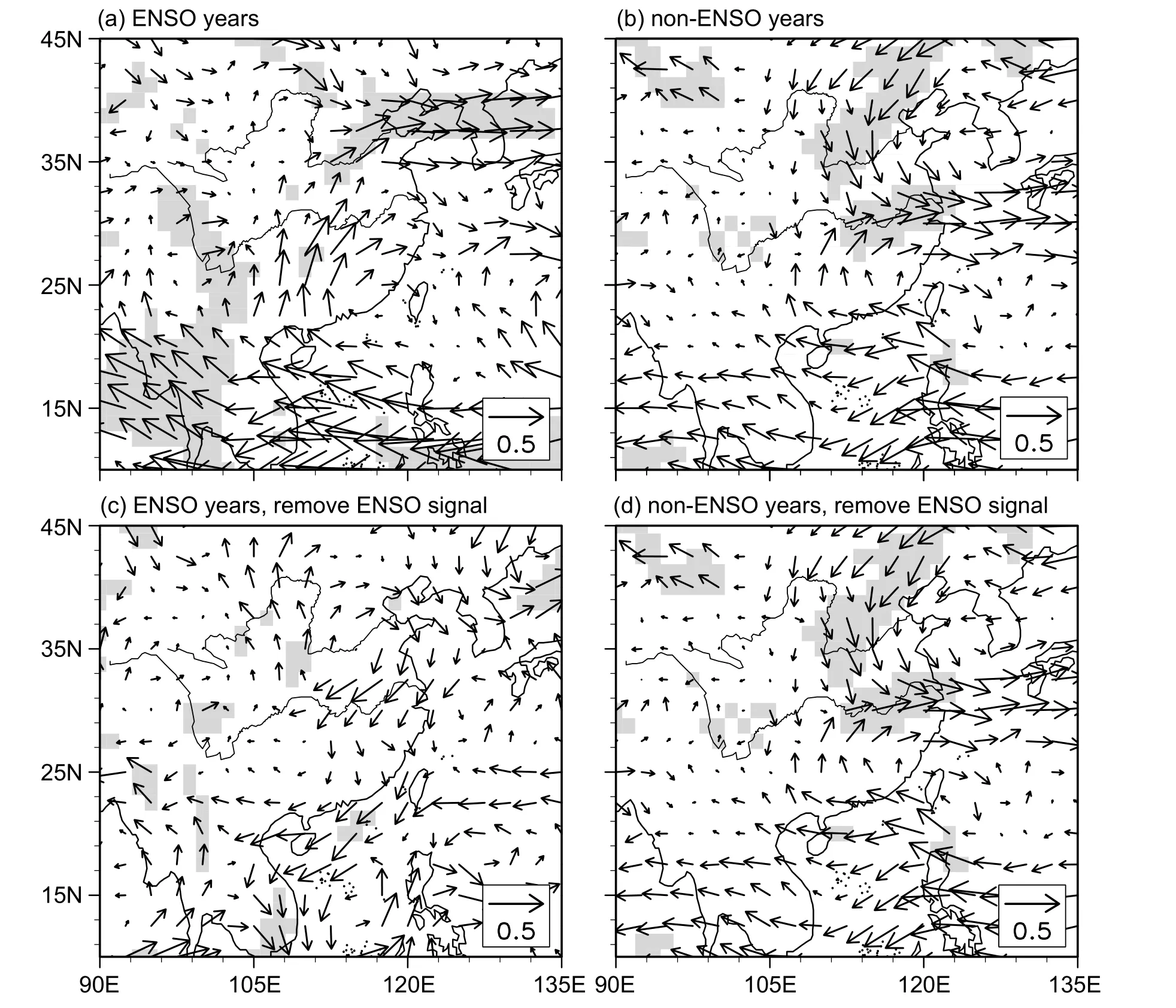
Fig.8.Regression of the summer 850-hPa wind anomaly (arrows; units: m s—1) with respect to (a) a negative SMI and (c) a negative SMI after removal of the ENSO signal for the ENSO years.Panels (b) and (d) are the same as in (a)and (c), but for the non-ENSO years.The shaded areas indicate significance with p < 0.05.
The atmospheric moisture is mainly concentrated in the middle and lower troposphere; thus, the low-level wind anomaly plays a decisive role in moisture transport.Figure 9 further shows that the abnormal water vapor flux in summer responds to the SMI in each case.In the ENSO years, the abnormal southwesterly wind related to the negative SMI is mainly over central China, leading to a convergence of local water vapor (Fig.9a).This could be due to the relatively strong WPSH associated with the abnormally warmer SST anomaly over the tropical eastern Pacific.Indeed, after removing the ENSO signal, the water vapor flux anomaly induced by the abnormal ICP soil moisture is weakened (Fig.9c).In comparison, the abnormal water vapor flux induced by the soil moisture anomaly is further east in non-ENSO years,which brings excessive moisture to the YRB (Figs.9b, d).The YRB exhibits water vapor convergence, which favors local summer precipitation.Correspondingly, the degree/extent of northward water vapor transport is weakened/limited over NC by the northerly wind anomaly.
In summary, the spring soil moisture anomaly over the ICP affects the summer monsoonal circulation through its persistent local thermal control, leading to abnormal vertical movements over the SC and anomalous water vapor transport over the YRB NC.However, such physical processes are suppressed in the ENSO years, when the ENSO SST anomaly overwhelms the atmospheric circulation system.On the contrary, under non-ENSO conditions, the ICP spring soil moisture anomaly offers strong seasonal predictability for summer precipitation over eastern China.
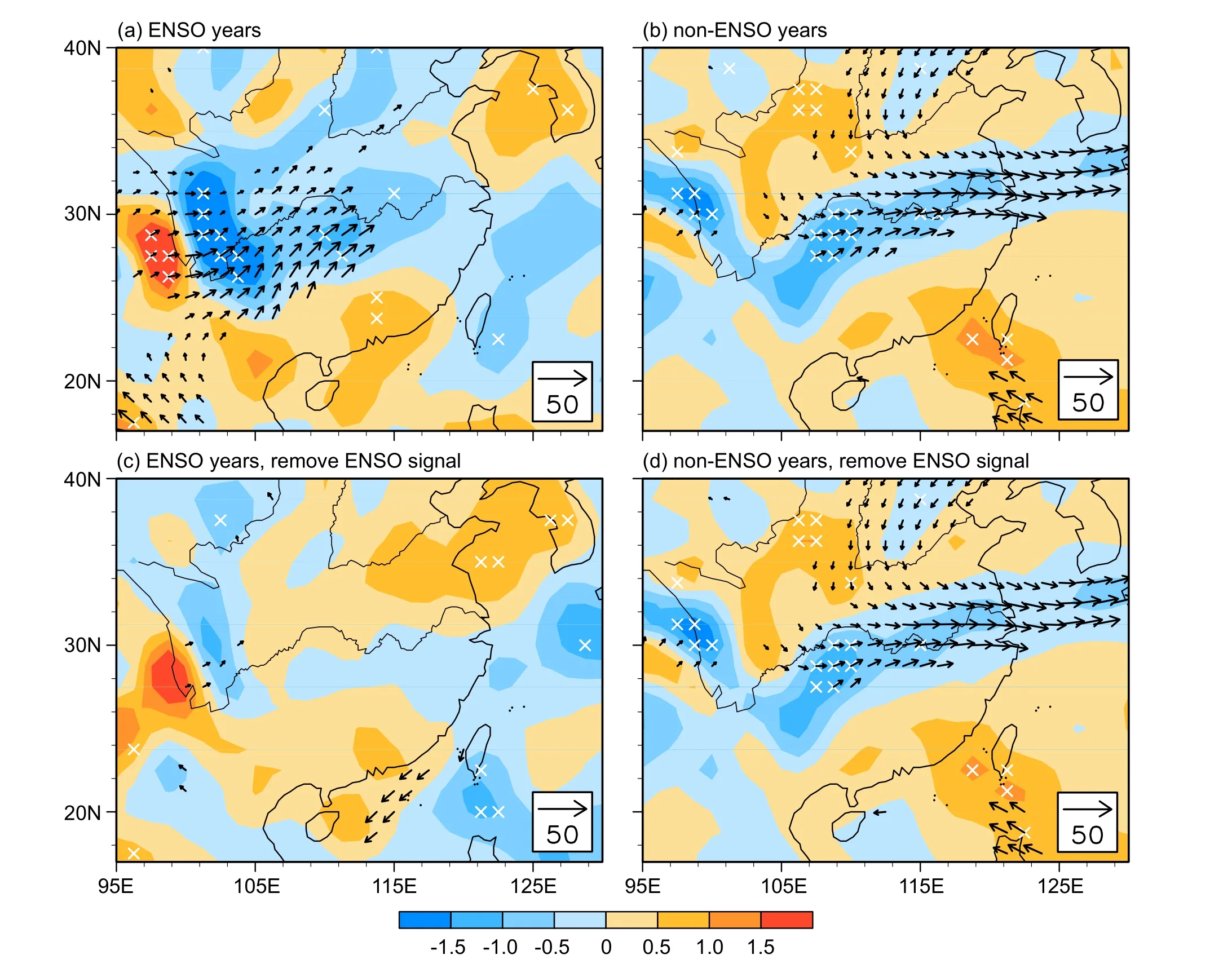
Fig.9.Regression of summer water vapor flux (arrows; units: kg m—1 s—1; the shown arrows are significant with p < 0.05)and its divergence anomalies (colors; units: 10—5 kg m—2 s—1; areas with white cross symbols are significant with p < 0.05)with respect to the negative (a) SMI and (c) SMI with the ENSO signal removed for the ENSO years.Panels (b) and (d) are the same as in (a) and (c), but for the non-ENSO years.
Precipitation anomalies over the monsoon regions are dominated by atmospheric circulation anomalies.As a main part of the East Asian summer monsoon circulation system,the WPSH anomaly is strongly linked to summer precipitation anomalies over eastern China (Ding et al., 2020).Finally,we defined a subtropical high index (SHI) using a standardized anomaly of the regionally averaged 500-hPa geopotential height in summer within the area of 18°—28°N and 110°—125°E (Fig.7b) to denote the east-west shift of the WPSH.Our findings are consolidated and made more intuitive by examining the relationships between the SMI and SHI in different cases, as in Fig.10.As shown in Figs.10a and b, the SMI exhibits robust negative correlations with the SHI in both ENSO and non-ENSO years.However, for the ENSO years, the strong tropical SST anomaly plays a key and dominant role in affecting the summer atmospheric circulation over the western North Pacific.Accordingly, the ICP spring soil moisture exerts little influence on the WPSH in summer.The correlation coefficient between the SMI with a removed ENSO signal and SHI is only -0.09 (Fig.10c).Under such a circumstance, the process of spring soil moisture over the ICP affecting summer precipitation over eastern China is muted.By contrast, the soil moisture affects the WPSH independently in the non-ENSO years, as reflected by the significant negative correlation coefficient of -0.31 between the SHI and SMI with a removed ENSO signal (Figure 10d).Therefore, the effect of the ICP spring soil moisture on eastern China summer precipitation is enhanced under non-ENSO conditions.
7.Summary and discussion
Summer precipitation anomalies over eastern China mainly depend on variations of the East Asian summer monsoon circulation, which is affected by multiple climatic factors (Ding and Chan, 2005; Ding et al., 2020).In previous studies, ENSO has been revealed to be the predominant seasonal predictive factor over tropical areas and significantly impacts East Asian climate (e.g., Wang et al., 2000; Feng and Li, 2011; Kosaka et al., 2013; Hu et al., 2014; Xie et al.,2016; Wen et al., 2019; Sun et al., 2021).In our study,spring soil moisture anomaly over the ICP is also found to be a potential seasonal predictor for eastern China summer precipitation under non-ENSO conditions.Located in the upper reaches of the East Asian summer monsoon system,ICP land surface plays a key role in modulating the monsoon circulation.During spring, soil moisture anomalies affect the local surface temperature over the ICP in such a way that when the land surface is abnormally dry, the temperature increases due to greater sensible heating.Due to its strong persistence (memory), the soil moisture anomaly can sustain itself until summer, resulting in higher temperatures over the ICP.Generally speaking, this anomalous surface heating increases the geopotential heights in summer, which can contribute to changing the East Asian summer monsoon circulation.Hence, the ICP spring soil moisture and the eastern China summer precipitation anomalies are interconnected.
In ENSO years, SST anomalies over the tropical ocean display their strong power in modulating global climate.Indeed, the wet-dry state of the ICP land surface is under the profound control of ENSO.During the ENSO decay in spring, an anomalous low-level anticyclonic circulation forms in association with the warmer SST anomaly over the tropical eastern Pacific and acts to transport more atmospheric moisture from the ICP into southern China.This leads to a precipitation deficit in spring over the ICP, which is the direct reason for a drier local land surface.Furthermore, the strong ENSO SST anomaly greatly impacts the summer atmospheric circulation.The WPSH extends further westward,associated with the strong warming over the tropical eastern Pacific in winter.A corresponding anomalous low-level anticyclone and tropospheric water vapor flux are also associated with the ENSO SST anomalies.Therefore, the ICP soil moisture anomaly in spring exhibits little influence on the East Asian summer monsoon circulation after removing the ENSO signals.With the suppressed effects of soil moisture anomalies on the summer atmospheric circulation, the linkage between the ICP spring soil moisture and eastern China summer precipitation is dramatically weakened.
However, under a non-ENSO condition, there is an obvious enhancement in the ICP spring soil moisture anomaly affecting the atmospheric circulation, even though the effects of ENSO SST anomalies on the ICP dry-wet states barely exist.The higher surface air temperature induced by lower soil moisture over the ICP increases the local geopotential height in the upper troposphere, favoring the westward extension of the WPSH in summer.Affected by the subtropical high, SC exhibits abnormal descending motions, suppressing precipitation.Meanwhile, the ICP dry soil moisture anomaly induces an anomalous anticyclonic circulation at the lower troposphere over southern China.Correspondingly, the enhanced southwesterly wind transports excessive water vapor into the YRB.At the same time, anomalous northerly flow in NC helps promote low-level moisture convergence and consequent rainfall in the YRB and also results in drier air in NC, which is evident in the weaker and restricted northward transport of water vapor to NC.Therefore, there is a tri-polar structure to the precipitation anomalies with precipitation deficits in summer over SC and NC and enhancements in the YRB associated with a negative ICP soil moisture anomaly during non-ENSO conditions.The converse tends to be true; the situation is usually the opposite when the ICP is abnormally wetter in spring.
Soil moisture, as the most important land factor for local thermal states, has strong memory and exhibits an evident seasonal climatic predictability (Seneviratne et al.,2010; Liu et al., 2017).In our previous study (Gao et al.,2019), the land-atmosphere interaction over the ICP in spring was revealed.Recent studies have further elucidated the seasonal prediction of summer climate and extreme climate events over the YRB using the ICP spring soil moisture(Yang et al., 2019; Gao et al., 2020a, b, c).In the current study, we investigated the ICP spring soil moisture, which affects the East Asian summer monsoon system and eastern China summer precipitation under the background of tropical SST anomalies.The strong influence of the ICP spring soil moisture on summer precipitation over eastern China in the quasi-normal SST years (non-ENSO years) would further deepen our understanding regarding seasonal climate prediction over East Asia.
Acknowledgements.This work was supported by the National Natural Science Foundation of China (Grant No.41831175), the Fundamental Research Funds for the Central Universities (Grant No.B210201029), the Key Scientific and Technological Project of the Ministry of Water Resources, P.R.China (SKS-2022001), the Joint Open Project of the KLME and CIC-FEMD(Grant No.KLME202202), and the Open Research Fund of the State Key Laboratory of Tropical Oceanography (South China Sea Institute of Oceanology, Chinese Academy of Sciences) (Grant No.LTO2110).We would like to acknowledge relevant institutions for providing the data sources for this study.The precipitation data was provided by the University of East Anglia Climate Research Unit (https://crudata.uea.ac.uk/cru/data/hrg/), the soil moisture data was provided by the Global Land Data Assimilation System version 2.0 (https://hydro1.gesdisc.eosdis.nasa.gov/data/GLDAS/),the atmospheric reanalysis dataset was obtained from the Japan Meteorological Agency (https://jra.kishou.go.jp/JRA-55/index_en.html), and the Oceanic Niño Index was gathered from the Climate Prediction Center of U.S.(http://origin.cpc.ncep.noaa.gov/products/analysis_monitoring/ensostuff/ONI_v5.php).
Electronic supplementary material:Supplementary material is available in the online version of this article at https://doi.org/10.1007/s00376-023-2361-x.
杂志排行
Advances in Atmospheric Sciences的其它文章
- The 17th Workshop on Antarctic Meteorology and Climate and 7th Year of Polar Prediction in the Southern Hemisphere Meeting
- Modulation of the Wind Field Structure of Initial Vortex on the Relationship between Tropical Cyclone Size and Intensity
- A Lagrangian Trajectory Analysis of Azimuthally Asymmetric Equivalent Potential Temperature in the Outer Core of Sheared Tropical Cyclones
- Coupling of the Calculated Freezing and Thawing Front Parameterization in the Earth System Model CAS-ESM
- The Processes-Based Attributes of Four Major Surface Melting Events over the Antarctic Ross Ice Shelf
- Hybrid Seasonal Prediction of Meridional Temperature Gradient Associated with “Warm Arctic-Cold Eurasia”
